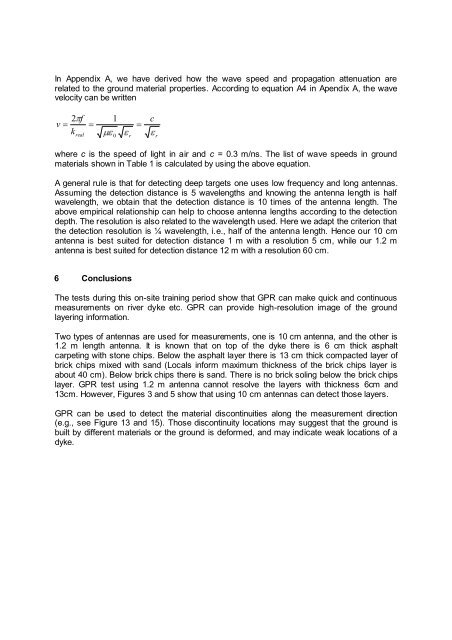GPR for river dyke - GSB
GPR for river dyke - GSB
GPR for river dyke - GSB
You also want an ePaper? Increase the reach of your titles
YUMPU automatically turns print PDFs into web optimized ePapers that Google loves.
In Appendix A, we have derived how the wave speed and propagation attenuation are<br />
related to the ground material properties. According to equation A4 in Apendix A, the wave<br />
velocity can be written<br />
v<br />
2 f<br />
k<br />
real<br />
1<br />
0<br />
r<br />
c<br />
r<br />
where c is the speed of light in air and c = 0.3 m/ns. The list of wave speeds in ground<br />
materials shown in Table 1 is calculated by using the above equation.<br />
A general rule is that <strong>for</strong> detecting deep targets one uses low frequency and long antennas.<br />
Assuming the detection distance is 5 wavelengths and knowing the antenna length is half<br />
wavelength, we obtain that the detection distance is 10 times of the antenna length. The<br />
above empirical relationship can help to choose antenna lengths according to the detection<br />
depth. The resolution is also related to the wavelength used. Here we adapt the criterion that<br />
the detection resolution is ¼ wavelength, i.e., half of the antenna length. Hence our 10 cm<br />
antenna is best suited <strong>for</strong> detection distance 1 m with a resolution 5 cm, while our 1.2 m<br />
antenna is best suited <strong>for</strong> detection distance 12 m with a resolution 60 cm.<br />
6 Conclusions<br />
The tests during this on-site training period show that <strong>GPR</strong> can make quick and continuous<br />
measurements on <strong>river</strong> <strong>dyke</strong> etc. <strong>GPR</strong> can provide high-resolution image of the ground<br />
layering in<strong>for</strong>mation.<br />
Two types of antennas are used <strong>for</strong> measurements, one is 10 cm antenna, and the other is<br />
1.2 m length antenna. It is known that on top of the <strong>dyke</strong> there is 6 cm thick asphalt<br />
carpeting with stone chips. Below the asphalt layer there is 13 cm thick compacted layer of<br />
brick chips mixed with sand (Locals in<strong>for</strong>m maximum thickness of the brick chips layer is<br />
about 40 cm). Below brick chips there is sand. There is no brick soling below the brick chips<br />
layer. <strong>GPR</strong> test using 1.2 m antenna cannot resolve the layers with thickness 6cm and<br />
13cm. However, Figures 3 and 5 show that using 10 cm antennas can detect those layers.<br />
<strong>GPR</strong> can be used to detect the material discontinuities along the measurement direction<br />
(e.g., see Figure 13 and 15). Those discontinuity locations may suggest that the ground is<br />
built by different materials or the ground is de<strong>for</strong>med, and may indicate weak locations of a<br />
<strong>dyke</strong>.


